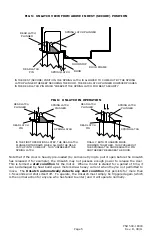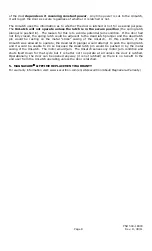
PN# 500-18300
Page 6
Rev. D, 08/11
4. WIRING
4.1 GENERAL ELECTRICAL CHARACTERISTICS
The UnLatch is a six wire device. Power (12 or 24VDC depending on the model) is applied to the
red and black wires observing polarity and power should be continuously present on these
wires. If you connect power in reverse, the UnLatch will not operate but it will be
damaged if left connected for an extended period of time. To operate the UnLatch, the
trigger wire (orange) should be connected to the red wire (+V) via an external switch.
When this connection is made, the UnLatch will release the door and keep it released so long as
the red and orange wires are connected. When connection between these wires is broken, the
door will be resecured (once it recloses). In certain applications the door is released all day and
secured all night. There is no problem operating the UnLatch in this manner (continuous duty)
but it is more common for the door to be released for only a few seconds at a time for controlled
entry. This is typically done by connecting the orange and red wires together from relay
contacts which close from an external card reader, digital keypad or keyswitch. The external
control device includes a timing function which will operate the UnLatch for a few seconds to
permit each entry. Like most conventional electric strikes, the UnLatch is fail secure which
means that it will maintain the door in a secure position if power is lost. Entry is not possible
but people can, of course, exit by simply turning the door handle or knob from the inside.
FIG. 7: UNLATCH WIRING
WHITE (STATUS: COM)
BLUE (STATUS: N.O.)
CLOSURE
BV IN
AND TRIGGER
RELEASES LATCH
+
-
ORANGE (TRIGGER)
GREEN (STATUS: N.C.)
POWER SUPPLY
RED (+V)
BLACK (NEG)
UNLATCH
POWER SHOULD BE CONSTANTLY CONNECTED
DC
In normal operation, the UnLatch draws about 300 mA @ 12 VDC or 200 mA @ 24VDC when it
operates (the motor is moving) and a steady 40 mA at all times. Note that regulated input
voltage is not required to operate the UnLatch. Full wave rectified DC is acceptable
(trans bridge rectifier). When using a UNL-24 with a 24VAC transformer (TP-24-2) and
bridge rectifier (BR-7) two additional components are required. These are two zener diodes
(1N5333B, 5 watt, 3.3 volt or equivalent) that you will find in a package separate from the
hardware pack. Because the peak voltage of a transformer and bridge rectifier combination can
be as high as forty volts the diodes are required to drop the peak voltage into the operable
range for the UNL-24. The following diagram (Figure 8) notes installation placement of the
zener diodes.
FIG. 8: ZENER DIODE PLACEMENT (UNL-24 , TRANSFORMER, BRIDGE RECTIFIER)
CROSS BAR
DENOTES CATHODE
BANDED SIDE
DENOTES CATHODE
Note diode orientation:
120
VAC
IN
VAC
OUT
+
TP-24-2
PLUG IN
TRANSFORMER
NC
C
NO
NC
C
NO
+
TRG
ORG
RED
BLK
UNL-24
PB2E
BR-4




























